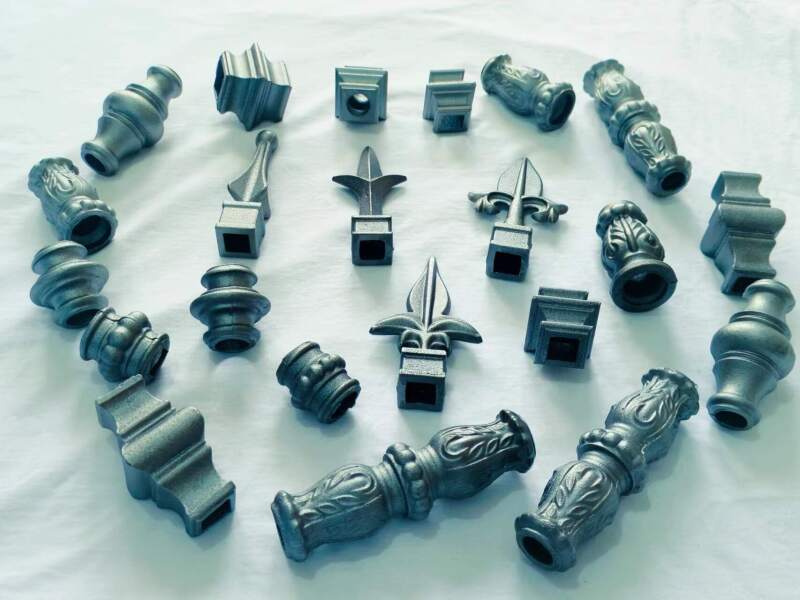
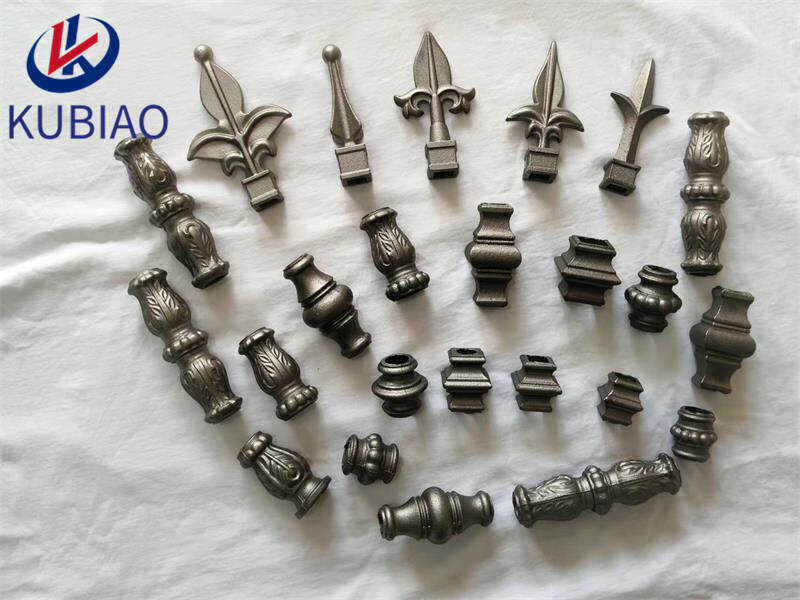
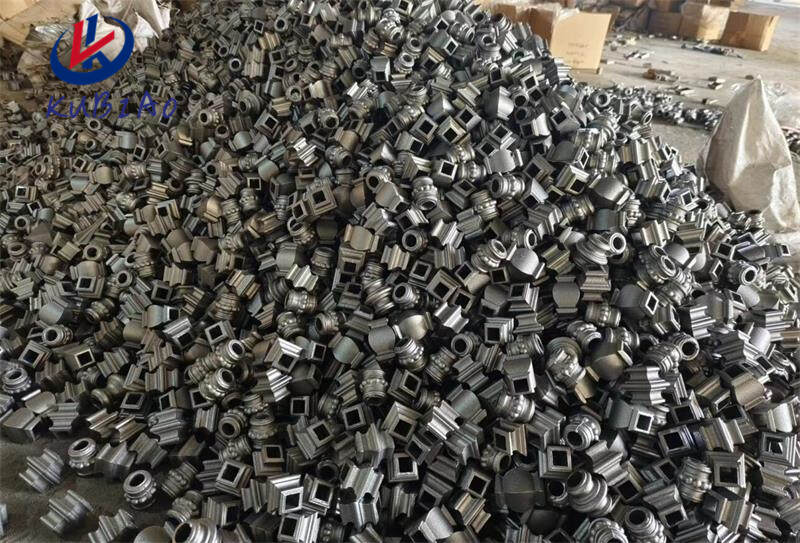
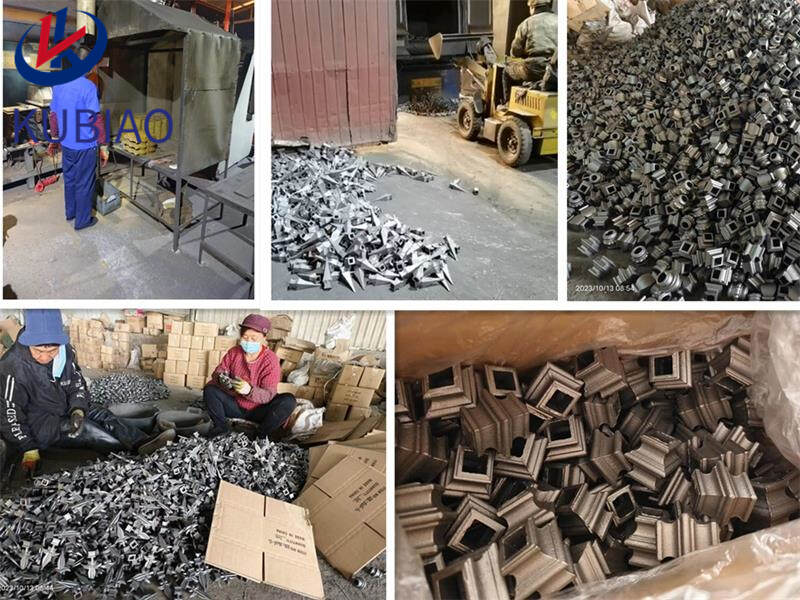
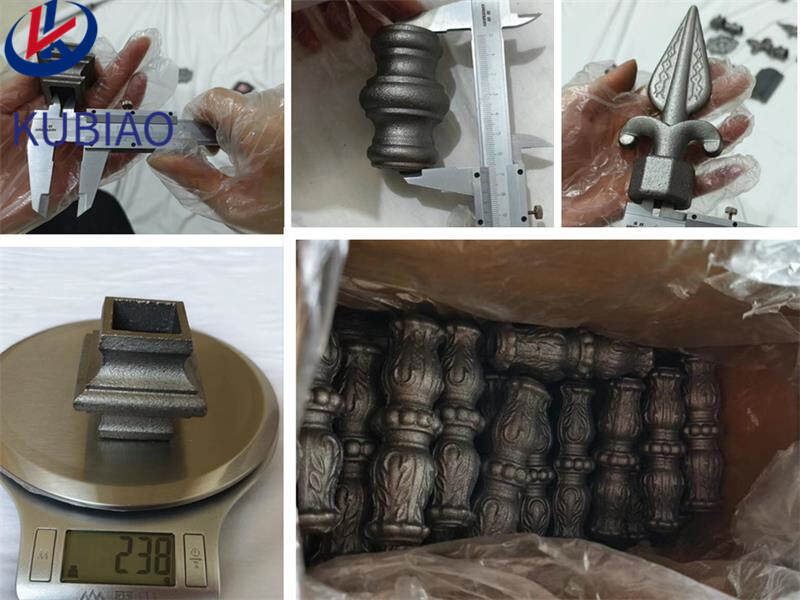
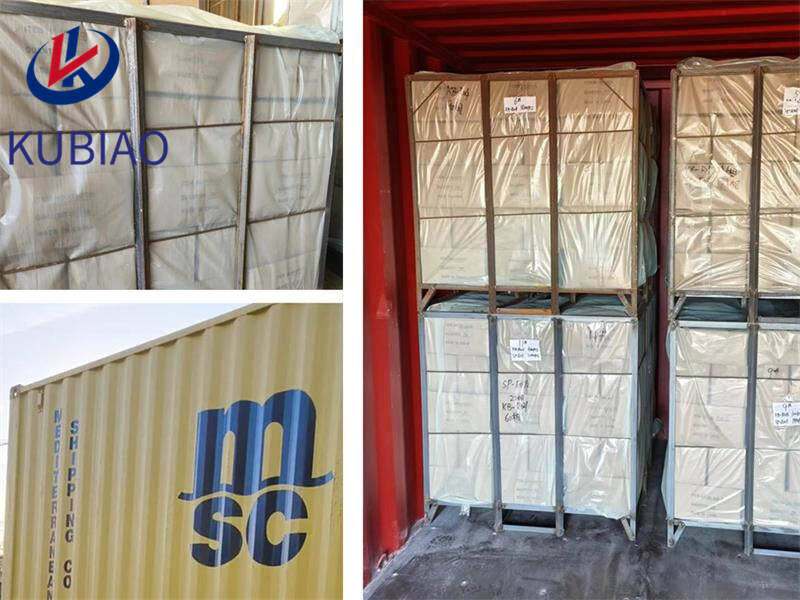
| Product name | cast iron fence cap |
| Keyword | cast iron ornamental castings ,cast iron ornamental fence parts ,iron fence ornaments,cast iron décor ,iron casting spear |
| Place of Origin | China |
| Quality standard | We have our own professional QC team to insure the quality. |
| Feature | Cast iron is a strong metal material that can withstand large amounts of pressure and weight. It is also durable and resistant to corrosion, making it ideal as a decorative item |
| Application scope | storage room, etc. |
| surface treatment | sand blasting antirust antirust oil/water painting hot dip galvanizing |
| Unit Weight(g) | 345(Contact us for specific information to confirm) |
| terms of payment | 50% T/T in advance, balance before shipment. |
| Life span | 20 years (Contact us for specific information to confirm) |
| delivery time | It usually takes 40 days. |
| Advantage | We keep good quality and competitive price to ensure our customers benefit |
| Packing | 20x15.72x9.5cm(Contact us for specific information to confirm) |
| OEM/ODM | Customization Service Provided |
| design | beautiful elegance sleek pretty |
| Sales country | All over the world for example:Benin,New Zealand,Sweden,Djibouti,Singapore |
| MOQ | 281pcs(Contact us for specific information to confirm) |
1.What are some creative ways to display cast iron fence cap?
We enjoy high authority and influence in the industry and continue to innovate products and service models.
1. Hang them on a rustic wooden ladder: Lean a wooden ladder against a wall and hang the cast iron ornaments from the rungs. This creates a unique and eye-catching display.
2. Create a wall collage: Arrange a variety of cast iron ornaments on a wall in a collage-style display. Mix and match different sizes and shapes for an eclectic look.
3. Use them as bookends: Place a pair of matching cast iron ornaments on either side of a row of books to create a functional and decorative display.
4. Display them in a terrarium: Place a few cast iron ornaments inside a glass terrarium for a whimsical and unexpected display.
5. Hang them from a chandelier: If you have a chandelier or light fixture with multiple arms, hang a few cast iron ornaments from the arms for a unique and elegant display.
6. Create a centerpiece: Arrange a few cast iron ornaments on a tray or platter and use them as a centerpiece on a dining table or coffee table.
7. Hang them from a branch: Find a sturdy branch and hang the cast iron ornaments from it using twine or ribbon. This creates a natural and rustic display.
8. Use them as garden stakes: Stick the cast iron ornaments into the ground in your garden or flower bed to add a touch of whimsy and charm.
9. Display them on a mantel: Arrange a few cast iron ornaments on a mantel along with other decorative items for a charming and festive display.
10. Hang them from a curtain rod: Use curtain clips to hang cast iron ornaments from a curtain rod for a unique and unexpected display.
2.Are cast iron fence cap weather-resistant?
We maintain a stable growth through reasonable capital operations, focus on industry development trends and cutting -edge technologies, and focus on product quality and safety performance.
Yes, cast iron ornaments are weather-resistant. They are made from a durable and strong material that can withstand various weather conditions, including rain, snow, and extreme temperatures. However, over time, they may develop rust if not properly maintained. It is recommended to regularly clean and seal cast iron ornaments to ensure their longevity and weather-resistance.
3.What is the history of cast iron fence cap?
We pay attention to the introduction and training of talents, scientifically regulate the management system, and focus on cultural construction and team cohesion.
Cast iron ornaments have a long and rich history dating back to ancient civilizations. The use of cast iron for decorative purposes can be traced back to the 5th century BC in China, where it was used to create intricate and ornate objects such as bells and statues.
In Europe, the use of cast iron for decorative purposes began in the 15th century, with the production of cast iron firebacks and grates for fireplaces. These were often adorned with intricate designs and patterns, and were considered a symbol of wealth and status.
During the Industrial Revolution in the 18th and 19th centuries, cast iron became more widely available and affordable, leading to an increase in its use for decorative purposes. Cast iron ornaments were used to decorate buildings, parks, and gardens, and were also popular as household items such as door knockers, garden furniture, and garden urns.
In the late 19th and early 20th centuries, the Victorian era saw a surge in the popularity of cast iron ornaments. The ornate and elaborate designs of the Victorian era were perfectly suited to the versatility of cast iron, and it was used extensively in the construction of buildings, bridges, and other structures.
However, with the advent of new materials such as steel and aluminum, the use of cast iron for decorative purposes declined in the 20th century. It was not until the lat<
br> 20th century that there was a renewed interest in cast iron ornaments, with a growing appreciation for their historical and aesthetic value.
Today, cast iron ornaments are still used to decorate buildings, parks, and gardens, and are also popular as collectibles and antiques. They are valued for their durability, intricate designs, and historical significance, and continue to be a popular choice for adding a touch of elegance and charm to any space.
4.Are there any eco-friendly options for cast iron fence cap?
We are committed to providing personalized solutions and established long -term strategic cooperative relationships with customers.
Yes, there are several eco-friendly options for cast iron ornaments:
1. Recycled Cast Iron: Look for cast iron ornaments that are made from recycled materials. This reduces the need for new resources and helps to minimize waste.
2. Sustainable Production: Some companies use sustainable production methods, such as using renewable energy sources and minimizing water usage, to create their cast iron ornaments.
3. Organic Coatings: Instead of traditional paint or varnish, some cast iron ornaments are coated with organic materials, such as linseed oil or beeswax, which are more environmentally friendly.
4. Fair Trade: Look for cast iron ornaments that are certified as fair trade, meaning they are produced in an ethical and sustainable manner, and workers are paid fair wages.
5. Vintage or Secondhand: Consider purchasing vintage or secondhand cast iron ornaments instead of new ones. This reduces the demand for new production and gives new life to old items.
6. DIY: If you have some basic metalworking skills, you can create your own cast iron ornaments using recycled materials or scrap metal.
7. Upcycled: Some companies specialize in upcycling old cast iron items, such as old radiators or pipes, into unique and eco-friendly ornaments.
8. Biodegradable Packaging: When purchasing cast iron ornaments, look for companies that use biodegradable or recyclable packaging materials to reduce waste.
9. Local Production: Choosing cast iron ornaments that are locally produced reduces the carbon footprint associated with transportation and supports your local economy.
10. Longevity: Cast iron ornaments are known for their durability and longevity. By choosing high-quality, long-lasting ornaments, you can reduce the need for frequent replacements and ultimately reduce waste.
5.How do I properly hang or display cast iron fence cap?
We have a wide range of cast iron fence cap customer groups and establishes long -term cooperative relationships with partners. The countries we provide services include Benin,New Zealand,Sweden,Djibouti,Singapore.
1. Choose a sturdy and secure location: Cast iron ornaments can be heavy, so it is important to choose a location that can support their weight. Avoid hanging them on weak or flimsy surfaces.
2. Use appropriate hardware: Make sure to use strong and durable hardware, such as heavy-duty hooks or screws, to hang your cast iron ornaments. Avoid using adhesive hooks or tape, as they may not be strong enough to hold the weight.
3. Consider the weather: If you are hanging your cast iron ornaments outdoors, make sure to use weather-resistant hardware and consider the elements. For example, if you live in a windy area, you may need to use additional hardware or secure the ornament with wire to prevent it from falling.
4. Use a level: Before hanging your ornament, use a level to ensure it is straight and even. This will help prevent it from tilting or falling off the wall.
5. Hang with care: When hanging your ornament, make sure to handle it with care to avoid damaging it. If the ornament has delicate or intricate details, use a soft cloth or gloves to handle it.
6. Display on a stand: If you prefer not to hang your cast iron ornament, you can also display it on a stand or shelf. Make sure the stand is sturdy enough to support the weight of the ornament.
7. Group similar ornaments together: If you have multiple cast iron ornaments, consider grouping them together for a cohesive display. This can also help distribute the weight evenly and prevent any one ornament from becoming too heavy for the display surface.
8. Regularly check for damage: Cast iron ornaments can be prone to rust and corrosion, especially if displayed outdoors. Make sure to regularly check for any signs of damage and address them promptly to prevent further deterioration.
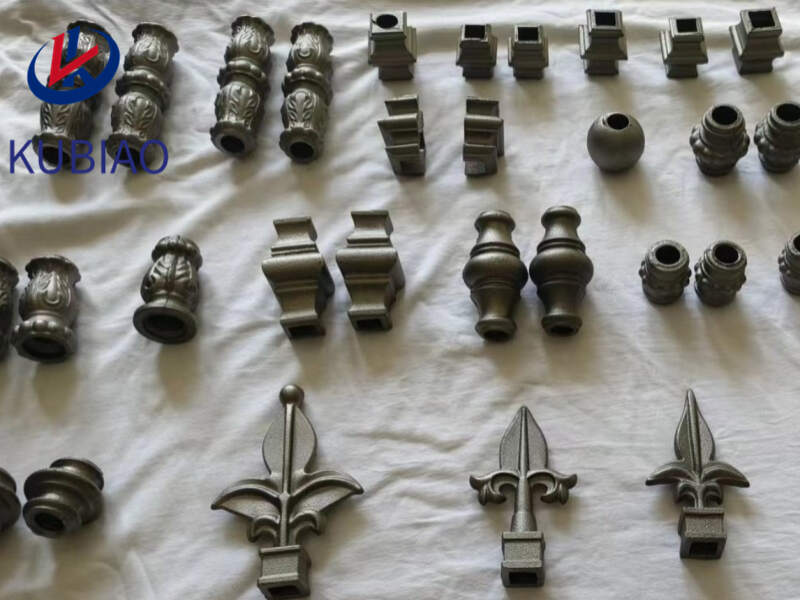
6.How do I protect cast iron fence cap from rust?
We pay attention to user experience and product quality, and provide the best product quality and lowest production cost for cooperative customers.
1. Clean and dry the ornaments: Before applying any protective coating, make sure the ornaments are clean and dry. Use a wire brush or sandpaper to remove any rust or dirt.
2. Apply a rust converter: Rust converters are chemical solutions that convert rust into a stable compound that can be painted over. Apply the converter according to the manufacturer's instructions and let it dry completely.
3. Use a rust-inhibiting primer: Once the rust converter has dried, apply a rust-inhibiting primer to the ornaments. This will create a barrier between the metal and the environment, preventing rust from forming.
4. Paint with a rust-resistant paint: After the primer has dried, paint the ornaments with a rust-resistant paint. This type of paint contains additives that prevent rust from forming.
5. Apply a clear coat: For added protection, you can apply a clear coat over the painted surface. This will provide an extra layer of protection against moisture and other elements.
6. Keep the ornaments dry: Moisture is the main cause of rust, so it's important to keep the ornaments dry. If they are placed outdoors, make sure they are covered or brought inside during rainy or humid weather.
7. Reapply protective coating regularly: Over time, the protective coating on the ornaments may wear off. It's important to reapply the rust converter, primer, and paint every few years to keep the ornaments protected.
8. Store indoors during winter: If possible, store the ornaments indoors during the winter months to protect them from harsh weather conditions.
9. Use a rust inhibitor: You can also use a rust inhibitor spray or gel to protect the ornaments. These products create a thin film over the metal, preventing rust from forming.
10. Regularly inspect and maintain: Regularly inspect the ornaments for any signs of rust and touch up any areas that may need it. This will help prevent rust from spreading and keep your ornaments looking like new.
7.Are cast iron fence cap suitable for indoor use?
We have been working hard to improve service quality and meet customer needs.
Yes, cast iron ornaments can be suitable for indoor use. However, they may require regular maintenance to prevent rusting and should be kept away from moisture. It is also important to ensure that they are properly secured to prevent any accidents.
8.How have cast iron fence cap evolved over time?
We focus on innovation and continuous improvement to maintain a competitive advantage.
Cast iron ornaments have evolved significantly over time, both in terms of their design and production methods. Here are some key changes that have occurred:
1. Early designs: The earliest cast iron ornaments were simple and functional, such as door knockers, hinges, and fireplace tools. These were often made using sand casting techniques and had a utilitarian look.
2. Victorian era: In the mid-19th century, cast iron ornaments became more decorative and ornate, reflecting the Victorian love for intricate designs and embellishments. This era saw the rise of cast iron garden furniture, fountains, and statues, often featuring elaborate floral and animal motifs.
3. Industrial revolution: With the advent of the industrial revolution, cast iron ornaments became more affordable and accessible to the middle class. This led to a proliferation of cast iron products, including street lamps, railings, and building facades.
4. Art Nouveau and Art Deco: In the late 19th and early 20th centuries, cast iron ornaments were influenced by the Art Nouveau and Art Deco movements, which favored more fluid and geometric designs respectively. This led to the creation of cast iron gates, grilles, and other architectural elements with intricate patterns and motifs.
5. Modern era: In the 20th century, cast iron ornaments continued to evolve, with a focus on functionality and minimalism. Modern designs often feature clean lines and geometric shapes, and are used in a variety of applications, from furniture to home decor.
6. Production methods: While sand casting was the primary method of producing cast iron ornaments in the past, modern techniques such as die casting and investment casting have made the process more efficient and precise. This has allowed for the creation of more intricate and detailed designs.
7. Materials: While cast iron was the preferred material for ornaments in the past, modern advancements have led to the use of other materials such as aluminum and bronze. These materials offer greater strength and durability, while still retaining the look and feel of cast iron.
Overall, cast iron ornaments have evolved from simple and functional objects to highly decorative and versatile pieces, reflecting the changing tastes and advancements in technology over time.
9.Are there any famous artists or designers known for their cast iron fence cap?
We have the leading technology and innovation capabilities, and attach importance to employee training and development, and provide promotion opportunities.
1. Thomas Jefferson
2. Gustave Eiffel
3. Antoni Gaudí
4. Louis Sullivan
5. Hector Guimard
6. Daniel Chester French
7. Augustus Saint-Gaudens
8. John Flanagan
9. René Lalique
10. Louis Comfort Tiffany
10.What are the origins of cast iron ornament production?
We focus on teamwork and communication to achieve common goals, We attach great importance to this detail.
The production of cast iron ornaments can be traced back to the 18th century in Europe, particularly in England and France. During this time, cast iron was becoming a popular material for architectural and decorative elements due to its strength, durability, and ability to be molded into intricate designs.
The Industrial Revolution in the 19th century further fueled the production of cast iron ornaments, as advancements in technology and manufacturing processes made it easier and more cost-effective to produce these decorative pieces. Cast iron ornaments were used extensively in the construction of buildings, bridges, and other structures, as well as in furniture and household items.
The popularity of cast iron ornaments continued to grow throughout the 19th and early 20th centuries, with the rise of the Victorian era and its emphasis on ornate and elaborate designs. However, the production of cast iron ornaments declined in the mid-20th century with the introduction of new materials and construction methods.
Today, cast iron ornaments are still produced and used in various architectural and decorative applications, but they are often considered a symbol of the past and are highly valued for their historical and aesthetic significance.
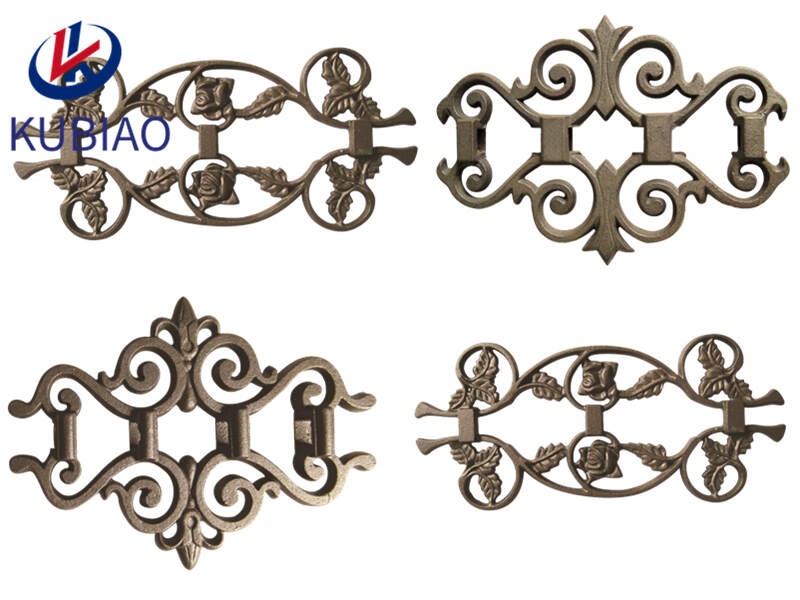
11.Can I customize my own cast iron fence cap?
We are centered on customers and always pay attention to customers' needs for cast iron fence cap products.
Yes, you can customize your own cast iron ornaments by using a variety of techniques such as painting, engraving, or adding embellishments. You can also create your own design or use a pre-made template to personalize the ornament. Additionally, you can choose the shape, size, and finish of the ornament to make it unique to your preferences.
12.What are cast iron fence cap?
We have flexible production capacity. Whether you are large orders or small orders, you can produce and release goods in a timely manner to meet customer needs.
Cast iron ornaments are decorative objects made from cast iron, a type of iron that is heated until it becomes molten and then poured into a mold to create a specific shape. These ornaments can range from small figurines and sculptures to larger architectural elements such as columns, balusters, and finials. They are often used to add a touch of elegance and charm to gardens, homes, and other outdoor spaces. Cast iron ornaments are known for their durability and can withstand harsh weather conditions, making them a popular choice for outdoor decor. They can also be painted or finished in various colors and styles to suit different design preferences.
13.What are the benefits of using cast iron fence cap in decor?
cast iron fence cap is not a product only, but also can help you comes to money-making.
1. Durability: Cast iron is a strong and durable material that can withstand harsh weather conditions and last for many years without losing its shape or color.
2. Versatility: Cast iron ornaments come in a variety of shapes, sizes, and designs, making them suitable for various decor styles and themes.
3. Timeless appeal: Cast iron has been used in decor for centuries, and its classic and elegant look never goes out of style.
4. Low maintenance: Cast iron ornaments require minimal maintenance, making them a practical choice for busy homeowners.
5. Adds character: The intricate designs and details of cast iron ornaments can add character and charm to any space.
6. Affordable: Cast iron ornaments are relatively affordable compared to other decorative materials, making them a budget-friendly option for home decor.
7. Indoor and outdoor use: Cast iron ornaments can be used both indoors and outdoors, making them a versatile choice for decorating any space.
8. Rust-resistant: Most cast iron ornaments are treated with a rust-resistant coating, making them suitable for outdoor use without worrying about corrosion.
9. Eco-friendly: Cast iron is a sustainable and eco-friendly material, making it a popular choice for those looking for environmentally friendly decor options.
10. Customizable: Cast iron ornaments can be customized to fit specific design preferences, making them a unique and personalized addition to any space.
14.Can cast iron fence cap be used as garden decorations?
We have a first -class management team, and we pay attention to teamwork to achieve common goals.
Yes, cast iron ornaments can be used as garden decorations. They are durable and weather-resistant, making them suitable for outdoor use. They can add a touch of elegance and charm to any garden or outdoor space. Some common cast iron garden ornaments include statues, fountains, planters, and decorative accents such as bird baths and garden stakes.
Welcome to contact us for Cast Iron Order!
Email: sales@kubiaometal.com
Cellphone/Whatsapp: 0086 13020588163
Wechat: 13028588163
Tag:cast iron post caps,cast iron fence post caps,ornamental iron fence parts ,iron ornament ,iron fence ornament ,fence metal stud ,cast iron spear points
PREV: cast iron fence caps
NEXT: cast iron end cap
Product
Category